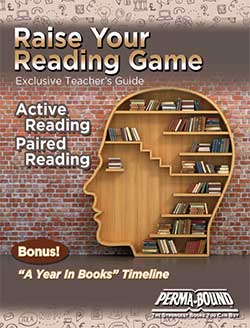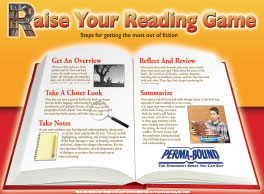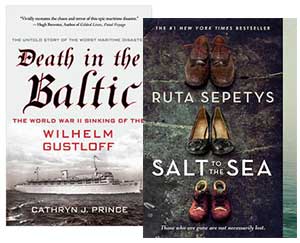Promote Active Reading with Perma-Bound!
As an English/Language Arts educator, one of your challenges is to foster your secondary students' engagement with classroom texts, particularly fiction. How can students read assigned books in such a way that they are able to identify key characters and plot points, and understand important ideas? Two important strategies to help your students get the most out of reading are active reading strategies and using paired texts. Below are some suggestions for incorporating both of these approaches in your classroom.
Introduction
Strategy 1: Encourage Active Reading

The Year in Books Timeline
Step 1: Get an overview. When you first pick up a book, quickly read the front and back covers, the inside covers or book jacket, the title page, the copyright page, and the table of contents, and quickly leaf through the book itself. If you are reading for pleasure or trying to pick between several options, this seemingly simple step will give you a quick idea of what the book is about and a feel for if it's right for you. Even the copyright page is important: it tells you when the book is written, so you'll have an idea if the sensibility is modern or if it's rooted in another historical era.
Step 2: Take a closer look. Now that you've chosen your book and have a general feel for it, go deeper into the book's language and meaning by reading the introduction and epilogue (if any), and the first and last paragraphs of each chapter. Scan through the pages to pick out recurring words, names, and other clues (such as unusual formatting or graphic elements) as well. Doing this will enable you to pick up cues, both consciously and subconsciously, as to what the book is about, including its main themes and characters. Try to get a general feeling for what the book is about and what will happen to the major characters. (These techniques can also be adapted for nonfiction books.)
Step 3: Take notes. As you read, reinforce your learning and understanding by taking notes in a form that's comfortable for you. This can include highlighting, underlining, and writing marginal notes (if the book belongs to you), or keeping a notebook with brief, chapter-by-chapter observations. Do this for important characters, plot developments, pieces of dialogue, or sections that just stand out or seem interesting. Partially, this technique is to help you keep track of important ideas, themes, character developments, etc., in the book you read. Partially, it's to reinforce learning by engaging motor activities- research shows that the more senses and muscle groups you engage in a task, the better you learn it. Finally, this technique helps trigger unconscious associations that will inform your understanding of the book.

Step 5: Summarize. Once you've read the book and really thought about it, the final step-especially if you're reading for a test or essay-is to create your own written summary of the book. Using your notes, and while the book is still fresh in your mind, write down a one- to three-page summary of the story. Include main characters, the setting, the story's main conflict, the main events, and the conclusion. Doing this final step will help deepen your recall and understanding.
“Some books are to be tasted, others to be swallowed, and some few to be chewed and digested”
- Sir Francis Bacon, English philosopher and author (1561-1626)
Strategy 2: Paired Texts
Using paired texts - pairing related fiction and nonfiction books - is another technique proven to enhance students' understanding and enjoyment of what they read. Pairing creates a synergy that helps achieve curriculum goals and improve learning outcomes, teaching students to evaluate multiple sources of information by requiring them to analyze two or more texts on the same topic, in either print or digital format. Doing this reinforces independent critical thinking and research skills.
 Here's how it works: Say, for instance,
students have been assigned the novel
Salt to the Sea, by Ruta Sepetys. This novel
concerns the harrowing experience
of Eastern European civilian refugees
during World War II, and their desperate
fight for survival on a German ship that was
sunk as it was attempting to transport them
to safety. You might pair this text with a
related nonfiction title such as Death in
the Baltic: The World War II Sinking of the
Wilhelm Gustloff, by Cathryn J. Prince, or
All But My Life, by Gerda W. Klein. Doing
so reinforces cross-curricular lessons in
history and social studies, while giving
students greater insight into the human
cost and emotional impact of historical
events through the lens of fiction.
Here's how it works: Say, for instance,
students have been assigned the novel
Salt to the Sea, by Ruta Sepetys. This novel
concerns the harrowing experience
of Eastern European civilian refugees
during World War II, and their desperate
fight for survival on a German ship that was
sunk as it was attempting to transport them
to safety. You might pair this text with a
related nonfiction title such as Death in
the Baltic: The World War II Sinking of the
Wilhelm Gustloff, by Cathryn J. Prince, or
All But My Life, by Gerda W. Klein. Doing
so reinforces cross-curricular lessons in
history and social studies, while giving
students greater insight into the human
cost and emotional impact of historical
events through the lens of fiction.
There are nearly endless ways in which fiction and nonfiction titles can be paired for maximum impact. Some suggested pairings (at multiple reading and interest levels) are available on our Paired Titles page.
